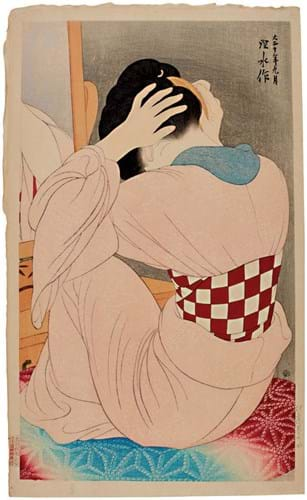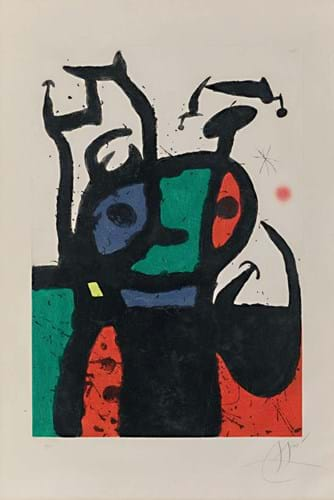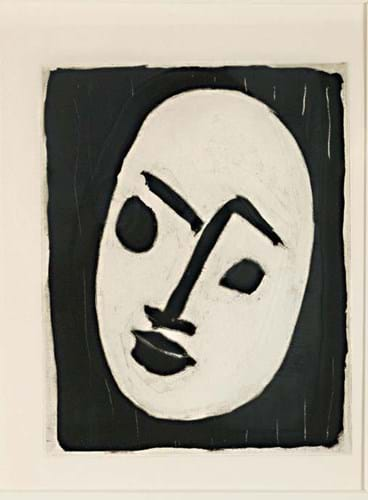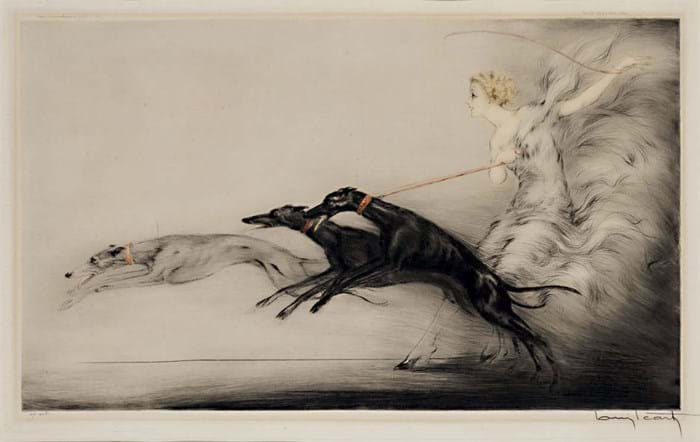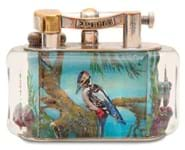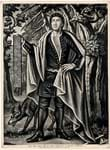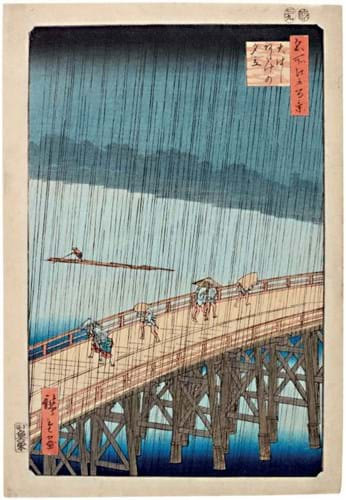
Sudden Shower over the Shin-Ohashi Bridge and Atake by Utagawa Hiroshige. A woodblock print from 1857, it sold for £230,000 at Sotheby’s.
One of the less reported and perhaps under-appreciated aspects of Freddie Mercury’s life was his great fascination for fine art prints.
Although largely hidden from public view, it was an interest that provided a notable refrain across the recent series of auctions at Sotheby’s of the late singer’s collection.
“I like to be surrounded by splendid things”, the Queen singer once said. “I want to lead the Victorian life, surrounded by exquisite clutter.”
Before achieving fame and entering the pantheon of pop music legend, Mercury had studied for a diploma in art and graphic design at Ealing Technical College and School of Art. It was an important time in his life – during this period he met drummer Roger Taylor and guitarist Brian May who were studying at separate London colleges and were part of a band called Smile that would later morph into Queen.
Having studied illustration and different print mediums, Mercury’s interest in graphic art remained throughout his life – although it very much played second fiddle to his great love of music, even at college. However, after graduating in 1969, he made use of his artistic training to design the Queen crest in 1972 which became the band’s logo.
Don’t stop me now
As the group shot to stardom in the mid-1970s and money began to roll in, Mercury started buying art in a serious way. After the band’s first tour of Japan in 1975, he developed a penchant for Japanese woodblock prints and began to acquire an expansive collection, buying from different sources including at auction. He bought a number of works at Sotheby’s sale of the Henri Vever collection of Japanese prints in London in 1977 and before long his burgeoning holdings began to be displayed prominently in his home.
In his house, Garden Lodge in Kensington, which he brought in 1980 and which had previously been the home of artists Cecil Rae and Constance Halford, Mercury restyled the ground-floor drawing room as the ‘Japanese Room’ and furnished it with antique furniture, porcelain, lacquered boxes, a 17th-century porcelain Kakiemon bowl as well as a host of 18th and 19th-century ‘ukiyo-e’ prints.
Other prints hung elsewhere. Among the pictures on display in his dining room was the highlight of his print collection: a copy of Utagawa Hiroshige’s (1797-1858) Sudden Shower over Shin-Ohashi Bridge and Atake.
The famous work, which inspired van Gogh’s oil painting Bridge in the Rain, is regarded as the masterpiece of the artist’s series One Hundred Famous Views of Edo and is one of the most sought-after prints by any Japanese artist.
Mercury first tried to buy a copy at the 1977 auction of the Vever collection. With Mary Austin, Mercury’s close friend, confidante and former girlfriend (as well as the vendor at the Sotheby’s) bidding on his behalf, they were eventually outbid as it sold on top estimate at £60,000 – three times higher than any previous copy of this individual print had fetched at the time.
It was only later when on a trip to Japan they were able to source another copy and Mercury’s longing to own a version of this print was finally fulfilled.
A kind of magic
Published between 1856-58, One Hundred Famous Views of Edo was an instant success. The prints proved so popular that the publisher Uoya Eikichi produced a deluxe edition shortly afterwards.
While it not known how many copies were produced in total, ukiyo-e printers could produce up to 200 prints in a day and so it is thought that up to 10,000 copies could well have been pulled.
On the current market, examples of the first state of both the original and deluxe edition are more valuable although they only occasionally appear. Mercury’s copy was an excellent example of the first state of the deluxe edition (it can be identified by the absence of two boats near the riverbank in the background and by its stronger colours compared to the ‘non-deluxe’ version of the print).
With this example showing few signs of wear (suggesting it may have been an early impression before the woodblock began to deteriorate), it was always likely to outscore the £30,000-50,000 estimate even without the extra cachet of the Mercury provenance.
Offered at the evening sale on September 6, the first of the six auctions of the Mercury collection at Sotheby’s, it attracted bidding in the room, on the phone, online and via commission with three bidders prepared to go over £100,000. It was eventually knocked down to one of the phones at a mammoth £230,000.
How much significance did the Mercury factor have on the final price? In short, a lot. The price was more than double the previous auction record for this print which, coincidently, was set at Sotheby’s in July last year when the Vever copy reappeared in an online-only sale and made £110,000. Mercury would have surely smiled seeing his own copy vastly outselling the copy for which he had missed out.
Indeed, throughout the auction inflated sums were bid for items way above their actual value as objects in themselves, whether prints, costumes or music memorabilia.
Another record bites the dust
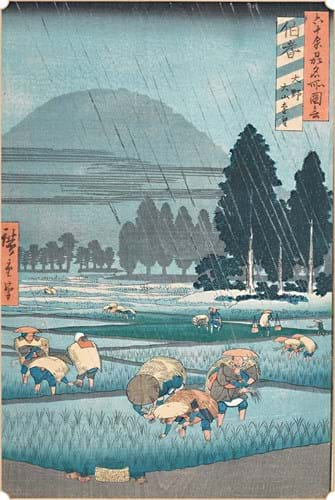
Hoki Province: Ono, Distant View of Mount Daisen, a woodblock pirnt by Utagawa Hiroshige, £26,000 at Sotheby’s.
Another Hiroshige print making a major record came in the Sotheby’s online sale of Japanese works that closed on September 11. Hoki Province: Ono, Distant View of Mount Daisen came from another series of the artist’s woodblock prints titled Famous Places in the Sixty-odd Provinces.
Measuring 13¾ x 9¼in (35 x 24cm), this was a copy of the 1853 first state and was also in good condition with excellent contrasts. It flew over a £2000-3000 pitch to take £26,000, smashing the previous highest recorded price for the print which was £5000 according to Artprice.com.
A total of 37 Japanese prints sold in the online auction, all bringing good demand including many examples depicting figures in ceremonial kimonos which were akin to the designs worn by Mercury on stage (plenty of which were also sold at Sotheby’s).
However, it was a print of a woman wearing an under-sash that topped the online auction. The woodblock print from 1921 by Ito Shinsui (1898-1972) measured 17 x 10½ in (44 x 26cm) and was from an edition of 200.
Overshooting a £1000-1500 estimate, it sold at £30,000, again more than doubling the previous high for this print: the $15,000 (£11,390) for an example sold at Bonhams New York in 2019.
Overall, 62 prints were offered across the different auctions, all of which sold for a combined hammer total of £1.02m (£1.3m with premium).
When it came to the European prints in the Mercury collection, five works featured as part of the evening sale, all from the Impressionist & Modern category.
A copy of Pablo Picasso’s (1881-1973) Jaqueline au chapeau noir, a linoleum cut from 1962, was yet another lot making a record for the edition. One of 50 signed copies (plus 35 artist’s proofs) published by Galerie Louise Leiris in Paris, it measured 20½in x 2ft 1in (52 x 64 cm) and had hung in Mercury’s kitchen at Garden Lodge.
Estimated at £50,000-70,000, it came down to a battle between two online bidders before being knocked down to a private buyer at £150,000, outselling another copy sold for $150,000 (£126,260) at a Sotheby’s New York online sale in November.
A signed copy of Joan Miró’s (1850-1931) Le Matador drew plenty of interest too with at least four bidders pursuing it well over the £15,000-20,000 estimate and up to £70,000 before it was knocked down on the phone to another private buyer.
A large etching from 1969, it measured 2ft 6in x 2ft 4in (1.07m x 74cm) and easily fetched more than any previous copy of this edition of 75 – three times more in this case according to Artprice.com.
One print that made over four times the previous auction high was a rare copy of Henri Matisse’s (1869-1954) Masque blanc sur fond noir.
Conceived in 1949-50 but printed posthumously in 1966 in an edition of 25, only a handful of copies have emerged at auction in the last 30 years – a key reason aside from the Mercury factor that ensured it drew such demand.
The 12½ x 10in (32 x 25cm) aquatint had the artist’s stamped signature and was believed to be a proof copy aside from the main edition. It was pitched at £3000- 500 but sold at £24,000, again to a different private buyer.
I want it all
Meanwhile, a group of seven etchings and aquatints by Louis Icart (1888-1950) were offered in the At Home sale – the third of the six sales of the Mercury collection – and remarkably posted the six highest auction prices for prints by the artist.
One of them was Hunting II, another proof aside from the general edition (in this case of 250 copies). The signed etching with aquatint from 1929 was pitched at £1000-1500 and sold at £19,000, yet another record for the edition.
Showing flamboyantly dressed figures, perhaps Mercury’s great love of costume gave even greater appeal for the Icart works (as well as works by artists like Erté whose works on paper he also collected)?
They certainly seemed to combine two different loves of his life – prints and costume – even if the former wasn’t much exhibited, while the latter certainly was.
The buyer’s premium at Sotheby’s was 26/20/13.9% plus 1% overhead premium.


